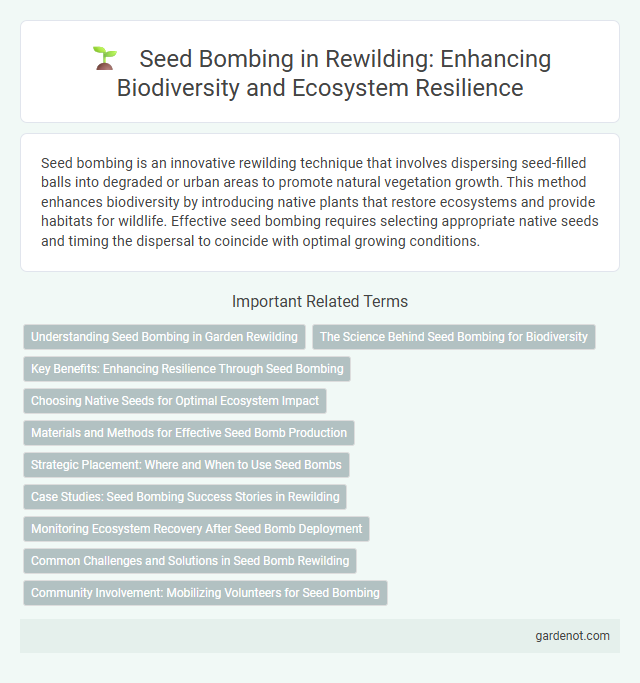Seed bombing is an innovative rewilding technique that involves dispersing seed-filled balls into degraded or urban areas to promote natural vegetation growth. This method enhances biodiversity by introducing native plants that restore ecosystems and provide habitats for wildlife. Effective seed bombing requires selecting appropriate native seeds and timing the dispersal to coincide with optimal growing conditions.
Understanding Seed Bombing in Garden Rewilding
Seed bombing involves dispersing clusters of native seeds encased in nutrient-rich balls to restore biodiversity in neglected or barren garden spaces. This technique promotes natural plant growth by improving soil health, enhancing pollinator habitats, and accelerating ecosystem recovery. Successful seed bombing relies on selecting region-specific plant species that thrive in local climatic and soil conditions to maximize rewilding impact.
The Science Behind Seed Bombing for Biodiversity
Seed bombing harnesses the natural dispersal mechanisms of native plant species to restore degraded ecosystems by introducing a diverse array of seeds encapsulated in nutrient-rich clay and compost. This technique enhances soil health, promotes microbial activity, and accelerates plant succession, which collectively boost local biodiversity and habitat complexity. Studies reveal that seed bombs increase seed germination rates in challenging environments, making them a cost-effective tool for large-scale rewilding projects aimed at ecosystem resilience.
Key Benefits: Enhancing Resilience Through Seed Bombing
Seed bombing promotes ecosystem resilience by dispersing diverse native plant species quickly across degraded landscapes, restoring habitats and improving soil health. This technique enhances biodiversity, supports pollinator populations, and stabilizes ecosystems against climate change impacts. By accelerating natural regeneration processes, seed bombing creates self-sustaining environments that require minimal human intervention.
Choosing Native Seeds for Optimal Ecosystem Impact
Selecting native seeds for seed bombing enhances ecosystem restoration by promoting local biodiversity and supporting indigenous wildlife. Native plants are adapted to the specific soil, climate, and pollinators of the region, ensuring higher germination rates and resilience. Using region-specific native seeds maximizes ecological benefits while minimizing the risk of invasive species disrupting habitat balance.
Materials and Methods for Effective Seed Bomb Production
Effective seed bomb production requires a blend of clay, compost, and native seeds to ensure moisture retention and nutrient supply for germination. The clay acts as a protective casing, preventing seed predation and desiccation, while compost provides essential organic nutrients that foster early plant growth. Mixing these materials into a malleable dough, shaping into small balls, and drying them before dispersal maximizes seed viability and supports successful rewilding efforts.
Strategic Placement: Where and When to Use Seed Bombs
Strategic placement of seed bombs targets degraded or hard-to-reach areas to accelerate natural regeneration and enhance biodiversity. Timing seed bomb deployment aligns with seasonal rainfall and soil conditions, optimizing germination and plant survival rates. Choosing locations near native plant species or ecological corridors maximizes habitat connectivity and ecosystem restoration success.
Case Studies: Seed Bombing Success Stories in Rewilding
Seed bombing has proven effective in rewilding efforts, with notable case studies such as the restoration of the Chernobyl Exclusion Zone, where native plant species rapidly recolonized contaminated lands. In urban environments like Detroit, seed bombing initiatives have transformed vacant lots into vibrant green spaces, enhancing biodiversity and community engagement. These success stories highlight seed bombing's role in accelerating habitat regeneration and promoting ecological resilience in degraded areas.
Monitoring Ecosystem Recovery After Seed Bomb Deployment
Monitoring ecosystem recovery after seed bomb deployment involves tracking plant germination rates, species diversity, and soil health indicators to assess restoration progress. Remote sensing technologies and field surveys provide data on vegetation cover and habitat quality changes over time. Regular analysis of these metrics ensures adaptive management and effectiveness in rewilding efforts.
Common Challenges and Solutions in Seed Bomb Rewilding
Seed bombing in rewilding faces common challenges such as seed predation by animals, poor germination rates due to soil conditions, and uneven distribution across target areas. Solutions include using a diverse mix of native seeds, incorporating biodegradable carriers enriched with nutrients, and timing deployment to align with optimal seasonal weather patterns. Employing community participation and monitoring enhances effectiveness by adjusting methods based on local ecological feedback.
Community Involvement: Mobilizing Volunteers for Seed Bombing
Seed bombing campaigns thrive on active community involvement, mobilizing volunteers to scatter native wildflower seeds across degraded urban and rural lands to restore biodiversity. Engaging local groups and schools amplifies outreach, fostering environmental stewardship while enhancing habitat connectivity for pollinators and wildlife. Volunteer-driven seed bombing accelerates rewilding efforts by transforming neglected spaces into thriving ecosystems through collective action.
Seed bombing Infographic

 gardenot.com
gardenot.com